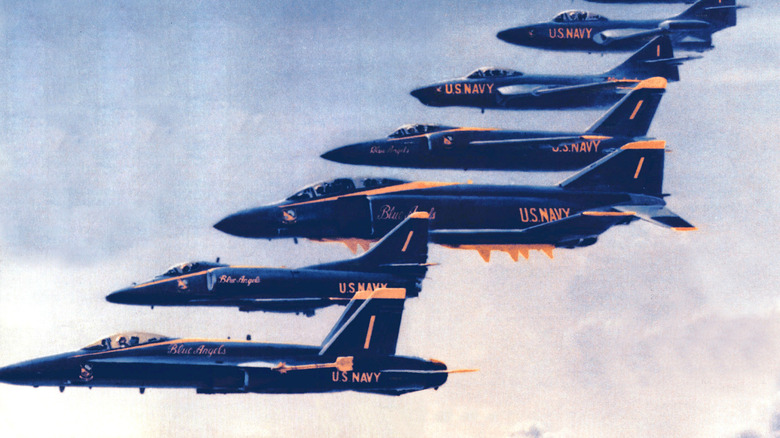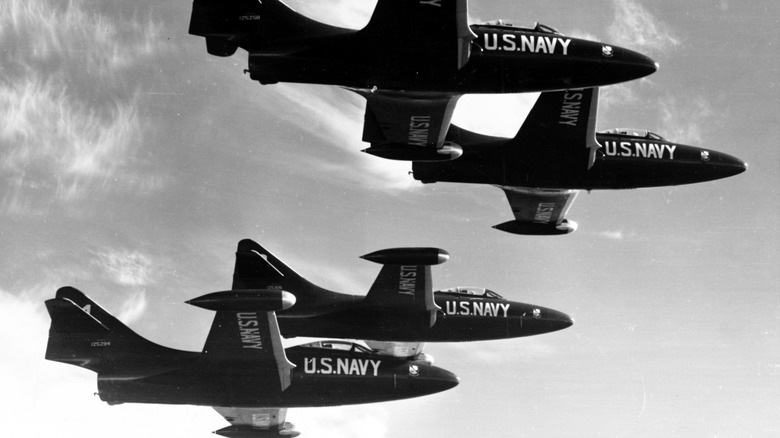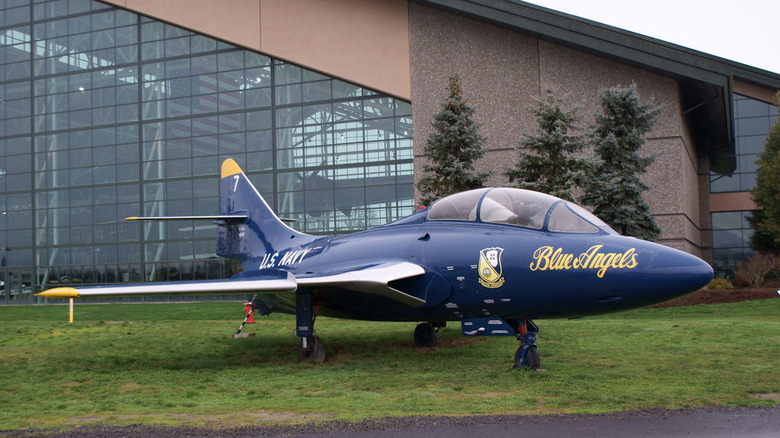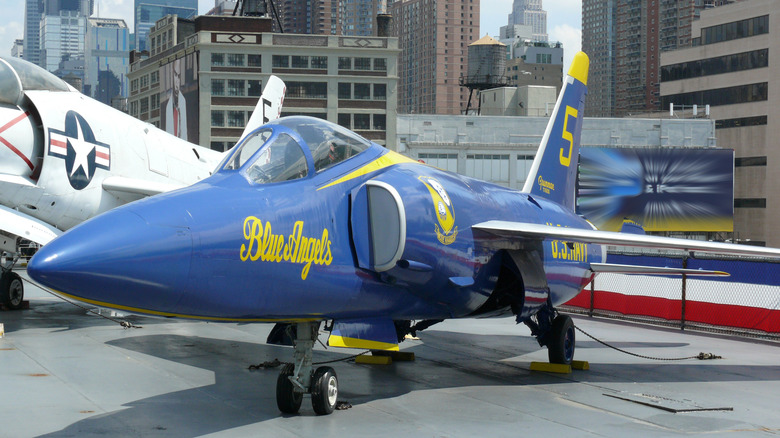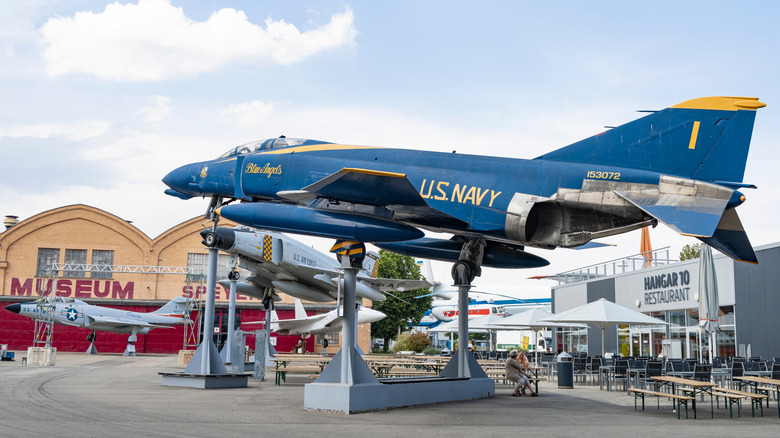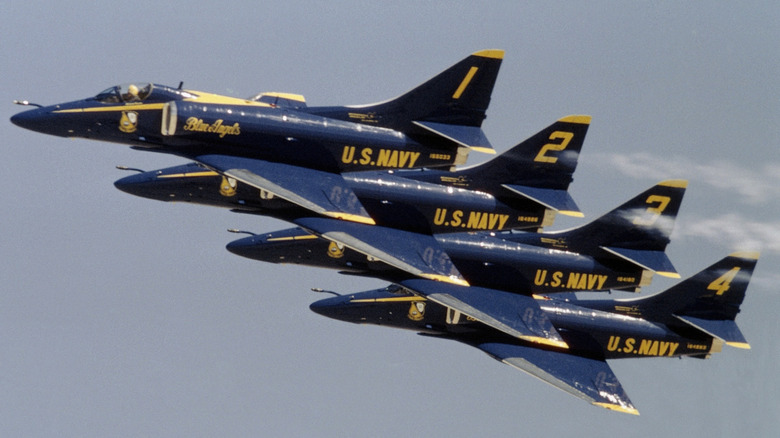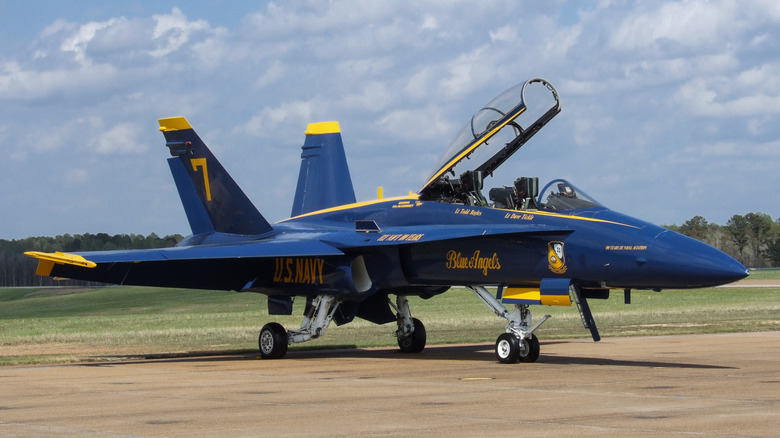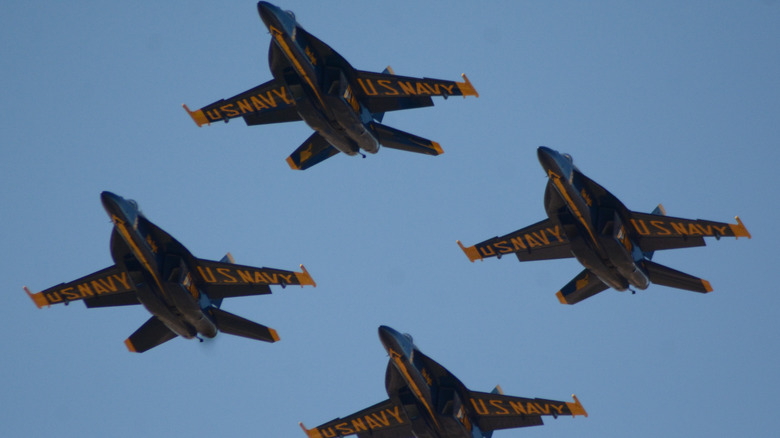Every Fighter Jet Flown By The Blue Angels, From 1946 To Present
The United States Navy Flight Demonstration Squadron, better known to aviation fans worldwide as the Blue Angels, first took to the skies as a team on June 15, 1946. Legendary Admiral Chester W. Nimitz, commander of the Pacific Fleet during the Second World War, envisioned a flight demonstration team to display the skill of the Navy's pilots for the public to see. Nimitz also saw the team as a way to boost the morale of the Navy. Eight decades on, the Blue Angels' signature blue and gold aircraft are synonymous with precision flying and military excellence.
Since 1949, the Blue Angels have flown jet fighters. Before that, they flew piston-engine aircraft, beginning with the Grumman F6F-5 Hellcat, a version of the carrier-based fighter that turned the tide of aerial combat against Japan's Mitsubishi Zero in the Pacific theater of World War II. The team would simulate combat against a North American SNJ Texan painted bright yellow to represent an enemy Zero. Later in 1946, the team transitioned to the F8F Bearcat, the final propeller-driven plane before switching to jet fighters in 1949.
The Blue Angels' war combat duties pulled them away from doing flight demonstrations in 1950 and 1951, during the Korean War, but the team soon began flying again. Since then, it has performed thousands of shows in some of the Navy's best jets in front of more than half a billion spectators around the world. Every show is a tribute to the skill of the fighter pilots as well as the talent of the crews in their support planes, their ground crews, and all honorary Blue Angels. The following is a list of every fighter jet the Blue Angels demonstration team has flown in it illustrious history.
Grumman F9F-2 and F9F-5 Panther
The Grumman F9F Panther was one of the first jets to operate from the US Navy's carriers and the first Navy jet to achieve an air-to-air victoryin Korea. The Blue Angels adopted the F9F-2 as its first jet demonstration aircraft in 1949, but shortly afterwards, the team was temporarily disbanded and its members sent to serve in Korea. When they returned to training in late 1951 before performing in 1952, they flew the F9F-5 variant. The two versions of the Panther would serve as the Blue Angels' wings from 1949 through 1955.
Since the team had been flying piston-engine fighters until 1949, the pilots needed to become qualified on the jet. They trained in the Panther during the week while continuing to fly the propeller-driven F8F Bearcat in flight demonstrations at weekend shows. On August 20, 1949, the Angels debuted the jet-powered Panther at an air show in Beaumont, Texas. Every aircraft the team has flown since has been a jet fighter, except for support aircraft like the C-130 Hercules. The Blue Angels moved headquarters to Florida, where the runway at Whiting Field in Pensacola was long enough to handle jet aircraft.
The Grumman F9F Panther was unique among the Navy's carrier aircraft. The F9F-1 sported four engines, but the unwieldy design left too little volume for carrying fuel. The F9F-2 became one of the first fighter jets with Pratt & Whitney engines after being fitted with that company's Nene turbojet, which generated 5,700 pounds of thrust. The F9F-5 was the final version of the Panther and produced 7,000 pounds of thrust from a Pratt & Whitney J-48-P-6 Turbojet engine. The F9F-5's top speed was 604 mph and its climb rate was 6,000 feet per minute, making it a powerful performer for the Blue Angels.
Grumman F9F-8 Cougar
The Blue Angels flying team's next jet was the Grumman F9F-8 Cougar, which was also the squadron's first swept-wing fighter jet. The Cougar was derived from the Panther that the team had flown previously, but its swept wing improved its speed to almost 90% of the speed of sound at Mach 0.895. This gave the jet a top speed of 705 mph, using 7,250 pounds of thrust developed by another Pratt & Whitney engine called the J48-P-8A.
The Angels would fly the Cougar from 1955 through 1957, moving to their current home base of NAS Sherman in Pensacola, Florida, one year after adopting the Cougar as their jet. During these years, they also adopted the six-plane show that they've used ever since, although now there's always a seventh Blue Angels jet flying behind the main formation, as well. The number seven jet provides a ride-along for members of the media and passengers selected by the Key Influencer program. This is part of the Navy and Marine Corps' outreach and recruiting efforts, selecting figures who are influential in schools or youth organizations.
The Cougar was designed to fight Soviet MiG-15s over Korea, but entered service after the war was over. Nevertheless, the Cougar achieved notable peacetime accomplishments. In addition to becoming the Blue Angels' jet, a variant completed the first sub 4-hour transcontinental flight in 1954. The Cougar's TF-9J training variant served until 1974, and ironically, it was these trainer versions that saw the Cougar's only combat service as a forward air control aircraft in Vietnam. Armaments consisted of four 20 mm cannons and four Sidewinder missiles or 2,000 pounds of bombs.
Grumman F11F-1 Tiger
The Blue Angels flew a variant of the Navy's first supersonic fighter jet, the F11F-1 Tiger, from 1957 through 1969. This means the Tiger lasted longer with the Blue Angels than it did with the rest of the Navy, where it was withdrawn from service by 1961. Nevertheless, the Tiger's sleek and modern appearance made it popular with air show crowds, and its afterburner-powered performance was definitely up to the Blue Angels' needs. In fact, the F11F-1 was so fast that in 1956, one of the aircraft shot itself down when it overtook some rounds from its own 20 mm cannons. Thankfully, the pilot survived the crash landing.
The Tiger incorporated cutting-edge aerodynamic concepts that enhanced supersonic performance, along with a cylindrical fuselage with swept wings optimized for high-speed flight. Full-span leading-edge slats improved low-speed lift characteristics, which was crucial for carrier operations, and the jet used spoilers rather than conventional ailerons for roll control. The Tiger was powered by a Wright J65 turbojet engine, which was a license-built version of the British Armstrong Siddeley Sapphire. The Tiger suffered from short range and engine reliability problems, and these issues, combined with being outperformed by the Vought F-8 Crusader, contributed to a brief frontline career.
The Combat Air Museum in Topeka, Kansas, displays an F11F-1 Tiger flown in the Blue Angels by Lieutenant Hal Loney. This model displays one of the Tiger's key aerodynamic features, known as area-rule, in which the fuselage narrows behind the wings in a way that's reminiscent of an old-fashioned soda bottle. Lt. Loney's aircraft entered service in 1958 and was moved to storage just 3 years later; after some stints as a trainer, it entered the Blue Angels' service in 1967.
McDonnell Douglas F4J Phantom II
The Blue Angels faced a special challenge in transitioning to the next jet, the F4J Phantom II, an aircraft few of the pilots had flown before. The F11F-1 Tigers were aging and the supply chain for them was stressed, since the Tiger was no longer in active production or service. Plus, the Air Force was considering switching to the F-4 Phantom, giving the Blue Angels even greater incentive to switch to a newer and more modern plane to keep pace with their Air Force rivals. But now they encountered one of the first challenges: The Phantom was in high demand due to the war in Vietnam.
The Blue Angels managed to acquire six out-of-service Phantoms to refurbish into jets worthy of wearing the Angels' blue and gold. Only one member of the team had combat experience flying the F-4, while others had ten hours or less in flight time in the jet, yet the pilots quickly took to their new wings. The same thing that made the F-4 Phantom an excellent fighter jet made it perfect for the Blue Angels: huge amounts of power. Its twin General Electric J79 turbojet engines produced 17,900 pounds of thrust each, giving the aircraft a maximum speed of 1,584 mph and the ability to haul up to 16,000 pounds of missiles and ordnance.
The Blue Angels customized the Phantoms to make them more suitable for flight demonstration. Flight mechanics added 25 pounds of pull to the stick via springs to eliminate inadvertent inputs and enable tighter formations. The engines were modified for a smoother transition to afterburner use. The Phantom's time with the Blue Angels was relatively short, lasting only from 1969 to 1974, but it became legendary among fans.
Douglas A-4F Skyhawk II
The Phantom's reign with the Blue Angels was cut short because of the rising price of fuel resulting from the oil crisis; The big, powerful jet was simply too expensive to keep flying as a flight demonstration aircraft. This led the team to switch to the much smaller and lighter A-4F Skyhawk II that would serve them well from 1974 until 1986, including the bicentennial year of 1976, during which the Blue Angels performed a grueling 80-show schedule. The nimble little jet proved to be perfect for aerobatic flying.
The Skyhawk was so much lighter than the Phantom that the A4-F variant made do with just one Pratt & Whitney J52-P408 engine generating 11,200 pounds of thrust. Eighteen A-4F versions of the Skyhawk were converted for use by the team, which was impressed with the performance of the J52 engine, an upgrade from earlier versions of the plane and the most powerful engine ever used in a Skyhawk. Despite this, it offered substantial fuel savings compared to the Phantom. Plus, the jet's maneuverability allowed the Blue Angels to fly tighter formations that were closer to spectators.
Unfortunately, the Skyhawk was accident-prone. Crashes are a part of life for pilots on demonstration teams like the Blue Angels, and 27 pilots have been killed in accidents during shows or training over the team's lifespan. The Skyhawk was involved in five crashes between 1977 and 1985, with several fatalities. This, combined with the plane's age, increased the Navy's urgency to switch the team over to the F-18 Hornet. Today, a Blue Angels' Skyhawk resides in the Museum of Flight in Seattle. After serving in Navy attack squadrons, it was transferred to the Blue Angels with over 2,700 hours of flight time on its logbooks.
McDonnell Douglas F/A-18 Hornet
The Blue Angels' switch to the F/A-18 Hornet can be seen as the transition to the modern era, since it still flies a variation of the Hornet today. The jet's long service with the team began with the F/A-18 A/B in 1986. It became the first plane in which the Angels performed shows in some former Eastern Bloc countries, including Romania and Russia, after the Cold War ended. In 2010, the Blue Angels adopted the newer F/A-18 C/D models, which would remain in demonstration service until 2020. The A and C designations indicate single-seater versions, while the B and D models were two-seaters.
The Hornet is a fighter jet with GE engines, being powered by variations of the GE F404 turbofan powerplant. For instance, an F/A-18C on display at the USS Hornet Museum sports F404-GE-402 enhanced performance turbofan engines that each generate 17,700 pounds of thrust. This is good for speeds exceeding Mach 1.7. The Hornet was designed to carry out air combat, attack, and reconnaissance missions with lethal proficiency. Aerodynamic innovations such as leading-edge extensions on the wings make this big airplane highly maneuverable, a quality honed for air-to-air combat that also serves the Blue Angels' needs well.
The Smithsonian Air and Space Museum acquired one of the Blue Angels' retired F/A-18C Hornets in 2020. This aircraft was deployed on three aircraft carriers and served in multiple combat missions before the Blue Angels acquired it in 2015. Its modifications were typical for the team's planes. Weapons were removed, the fuel system was modified for longer periods of inverted flight, and spring tension was added to the joystick. A stopwatch on the console helps pilots to keep track of timing during air show maneuvers.
Boeing F/A-18 Super Hornet
In 2020, the Blue Angels retired the F/A-18 Hornets and switched to flying the F/A-18 Super Hornet. The team first performed in the Super Hornet during the 2021 air show season, and it remains its primary jet to this day. Most of the team flies the F/A-18 E single-seat version, while the number 7 jet is a two-seater F/A-18 F that gives rides to civilians as part of the Blue Angels' outreach efforts. There are several differences between the F-18 Hornet and the Super Hornet, beginning with size. The Super Hornet is 20% larger and has a 15,000-pounder greater maximum weight compared to the older Hornet, making it effectively an all-new aircraft.
The Super Hornet also carries one-third more fuel, giving it over 40 percent greater flying range despite its additional weight. Its aerial refueling system (ARS) can refuel other aircraft, giving it an airborne tanker capability. All of the team's Super Hornets have extensive service histories prior to becoming part of the Blue Angels' inventory, although they receive new tail numbers in the role. The jets are often called Rhinos, and though the reason for the Super Hornet's Rhino nickname is obscure, it may be due to the protruding radar dome on the aircraft's nose.
As with earlier jets, the Super Hornet receives several modifications before entering service with the Blue Angels. These include a tension spring in the joystick for more precise control, a clear canopy for better visibility during maneuvers, fuel pumps optimized for inverted flight, and an oil tank with piping to the engine exhaust to produce smoke trails. They receive additional structural and electrical modifications to meet the needs of demonstration flying.
